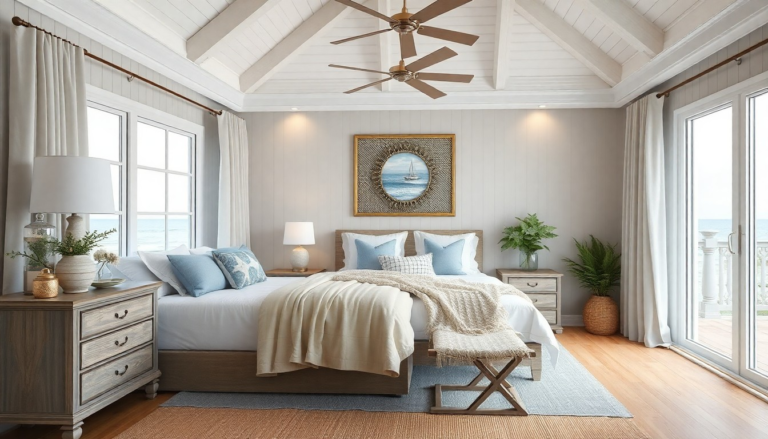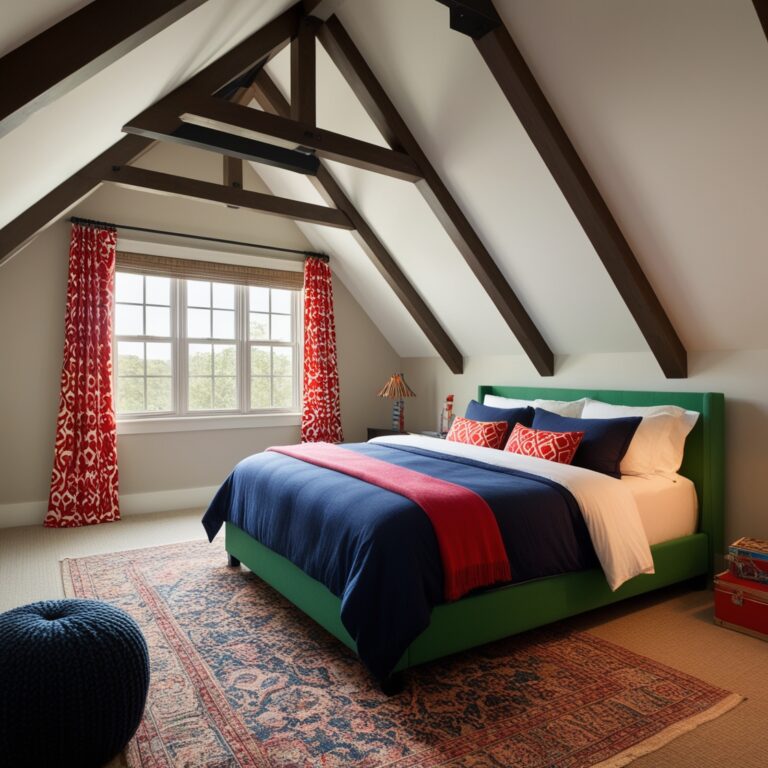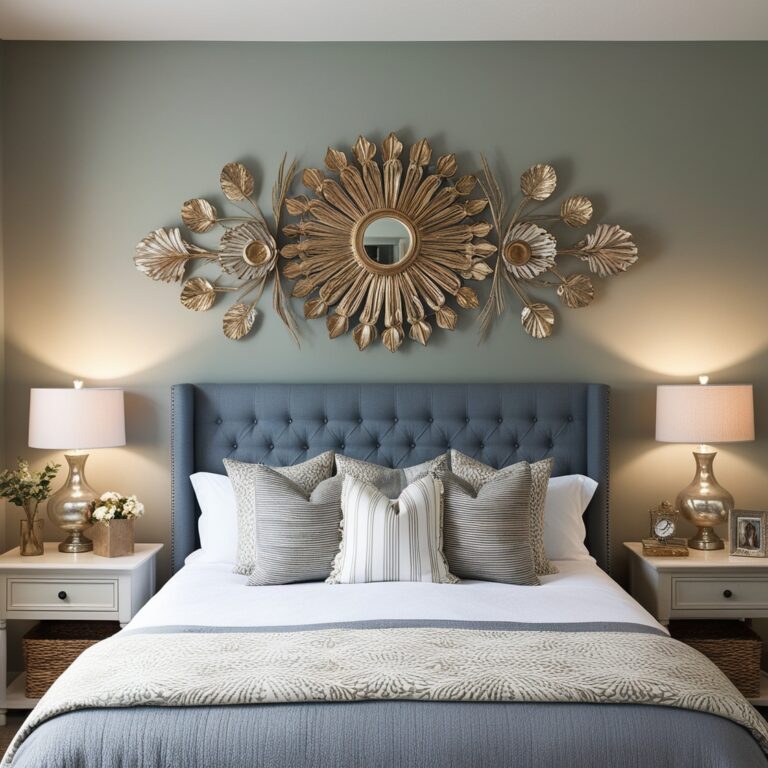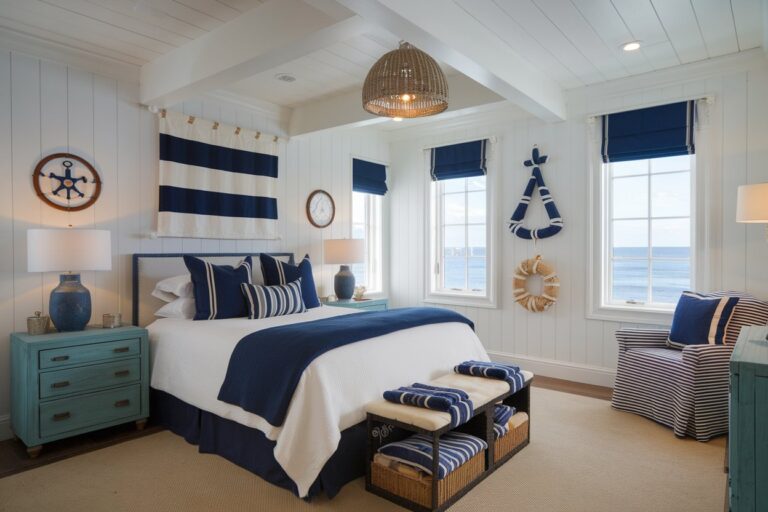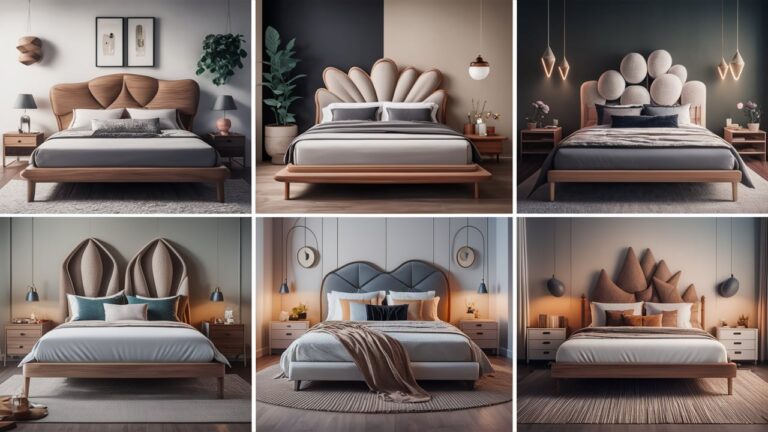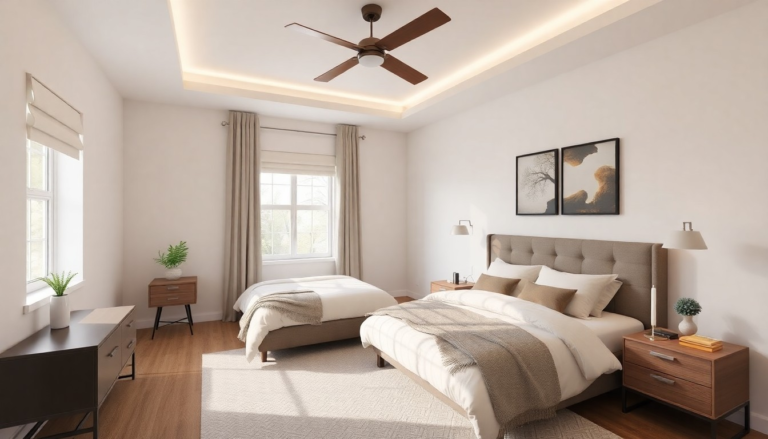57+ Best Sage Green Bedroom Ideas That Feel Serene
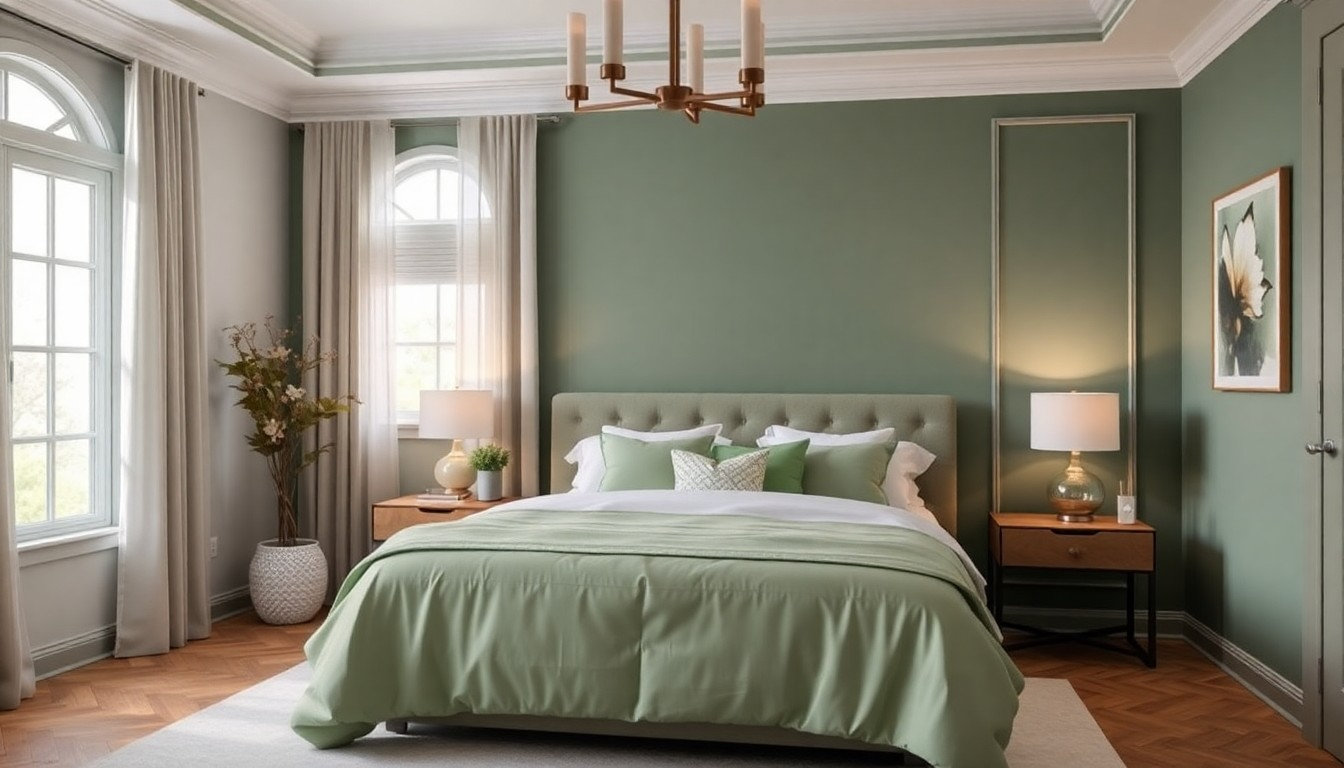
If you’ve ever walked into a room painted in sage green and felt an instant sense of calm, you’re not imagining it.
This muted, earthy tone has a way of wrapping you in tranquility like a warm hug from nature itself.
Think of it as the Goldilocks of colors—not too bright, not too dull, but just right.
It’s no wonder that sage green has become one of the most sought-after shades for bedrooms.
Whether you’re redecorating or starting fresh, this versatile hue can transform your space into a sanctuary.
Sage green works because it strikes the perfect balance between warmth and coolness.
It’s soothing without being boring, elegant without feeling pretentious.
Studies show that green tones, especially muted ones like sage, have a calming effect on the mind.
According to a 2019 study published in the Journal of Environmental Psychology , people exposed to green environments reported lower stress levels and improved mood.
Imagine bringing that same serenity indoors—into your bedroom, where relaxation is key.
Choosing the Right Shade of Sage Green
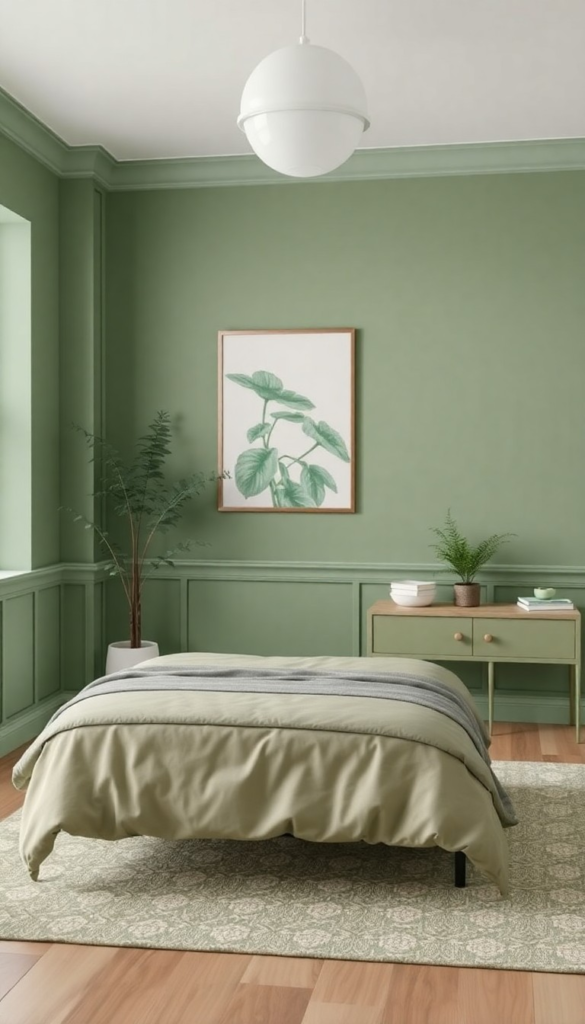
Not all sage greens are created equal, and picking the wrong shade could leave your bedroom feeling flat instead of fabulous.
The trick lies in understanding undertones and lighting conditions—two factors that can make or break your color choice.
Think of it like choosing the perfect avocado at the grocery store: you need to know what to look for to avoid ending up with something bland or overly ripe.
First, let’s talk about undertones. Sage green can lean warm (with hints of yellow or beige) or cool (with blue or gray undertones).
Warm sage greens, like Benjamin Moore’s Holly Springs or Sherwin-Williams’ Sea Salt , bring a cozy, inviting vibe to smaller spaces or rooms with limited natural light.
They work beautifully in bedrooms where you want to evoke a sense of warmth and comfort.
On the other hand, cooler sage greens, such as Farrow & Ball’s Pigeon or Behr’s Grey Green , add a touch of sophistication and pair well with metallic accents like brushed nickel or chrome.
These shades shine in larger rooms or spaces flooded with sunlight, as they prevent the room from feeling overly saturated.
Pairing Sage Green with Complementary Colors
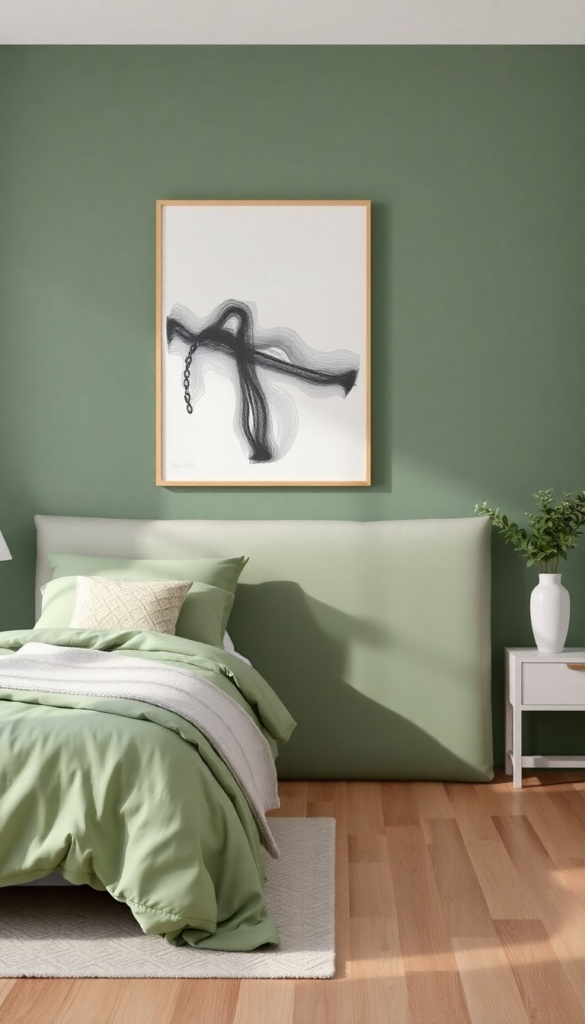
Once you’ve nailed down your perfect shade of sage green, it’s time to think about the supporting cast.
Just like a great movie needs strong supporting actors, your sage green walls will shine brightest when paired with the right complementary colors.
The goal here isn’t just to match hues but to create a harmonious palette that enhances the overall mood of your bedroom. Let’s break it down.
Neutrals: The Unsung Heroes
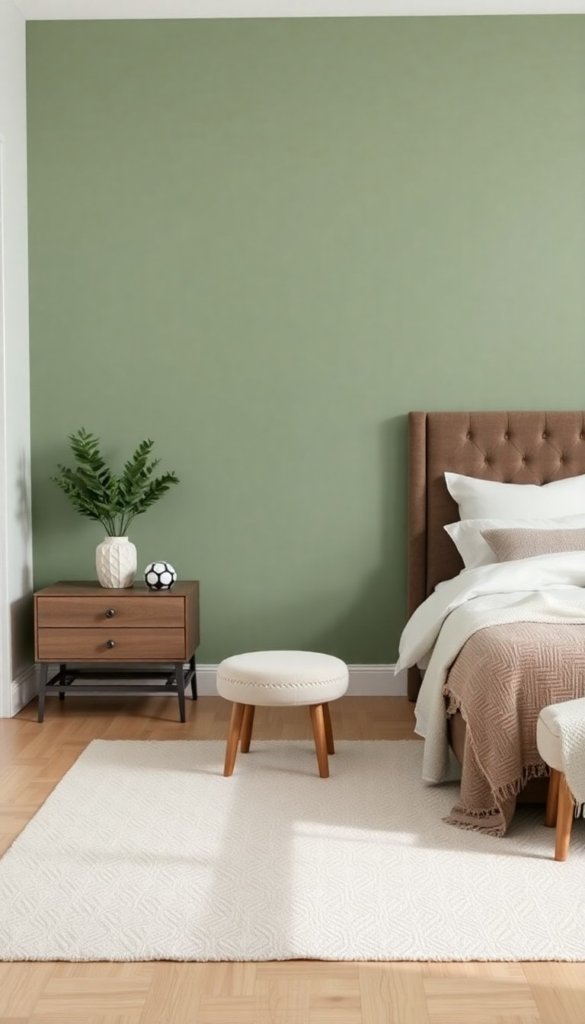
Neutrals are the bread and butter of any sage green bedroom.
They act as a grounding force, ensuring the space feels balanced rather than overwhelming.
Beige , taupe , and warm gray are particularly effective because they echo the earthy undertones of sage green.
Picture a soft beige throw blanket draped over a sage green upholstered chair—it’s understated elegance at its finest.
If you’re aiming for a minimalist aesthetic, stick to these neutral tones for bedding, rugs, and curtains.
They’ll let the sage green walls take center stage without competing for attention.
For those who love a bit of contrast, white is your best friend.
Crisp whites—whether in linens, lampshades, or artwork frames—create a clean, fresh look that keeps the room feeling airy.
However, if stark white feels too clinical, try an off-white or ivory instead.
These softer whites blend seamlessly with sage green while still providing that much-needed brightness.
Metallic Accents: A Touch of Glamour
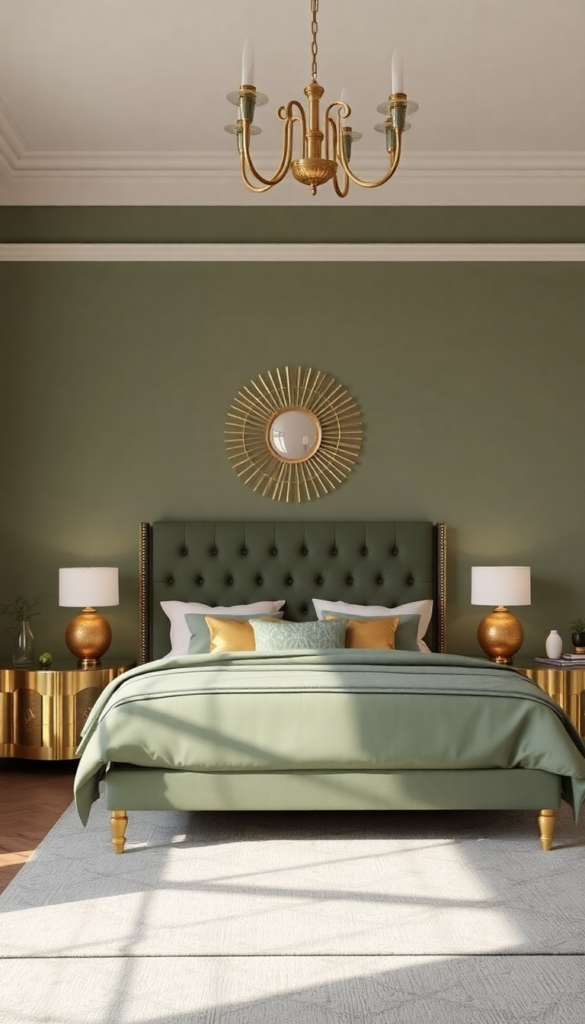
If you’re looking to elevate your sage green bedroom from serene to stunning, metallic accents are your secret weapon.
Gold , brass , and copper bring warmth and luxury, making them ideal companions for warmer sage greens.
Imagine a brass-framed mirror hanging above a sage green dresser or gold bedside lamps casting a soft glow across the room.
These touches don’t need to be over-the-top—a few strategically placed items can make all the difference.
On the flip side, cooler sage greens pair beautifully with silver and nickel accents.
Think sleek silver drawer pulls, a mercury glass vase, or a nickel-finished floor lamp.
These cooler metals add a modern edge that prevents the room from feeling too rustic or traditional.
Personally, I adore mixing metals—like pairing a copper table lamp with silver photo frames—for a layered, eclectic look.
Pops of Color: Bold but Balanced
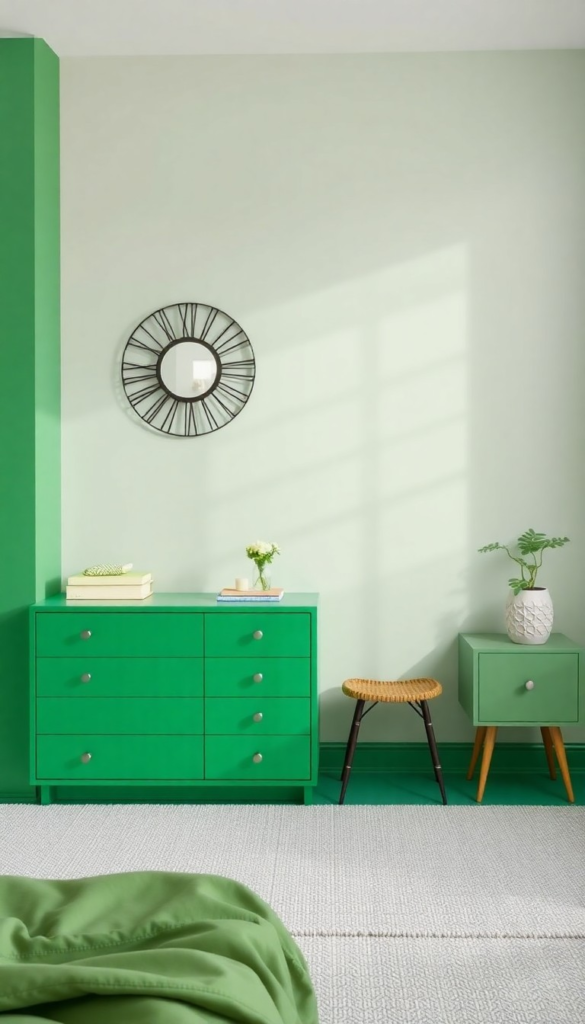
While neutrals and metallics provide stability, pops of color inject personality and energy into the space.
When working with sage green, choose colors that complement its muted tone without overpowering it.
Blush pink is a perennial favorite, offering a romantic contrast that feels both playful and refined.
Try blush-colored throw pillows or a patterned rug with hints of pink woven throughout.
For something bolder, consider mustard yellow or terracotta .
These rich, earthy tones harmonize beautifully with sage green, creating a cozy, autumnal vibe.
A mustard yellow armchair or terracotta ceramic vases can serve as eye-catching focal points.
And if you’re feeling adventurous, don’t shy away from navy blue or deep teal .
These jewel-toned hues add depth and drama, especially when used sparingly in art pieces or accent furniture.
The key to using pops of color effectively is restraint.
Too many bold elements can overwhelm the calming essence of sage green.
Instead, sprinkle them throughout the room in small doses—like a navy blue throw blanket or a single piece of abstract art featuring mustard yellow streaks.
Trust me, less is often more when it comes to adding vibrancy to a serene space.
Furniture Styles That Elevate Sage Green Bedrooms
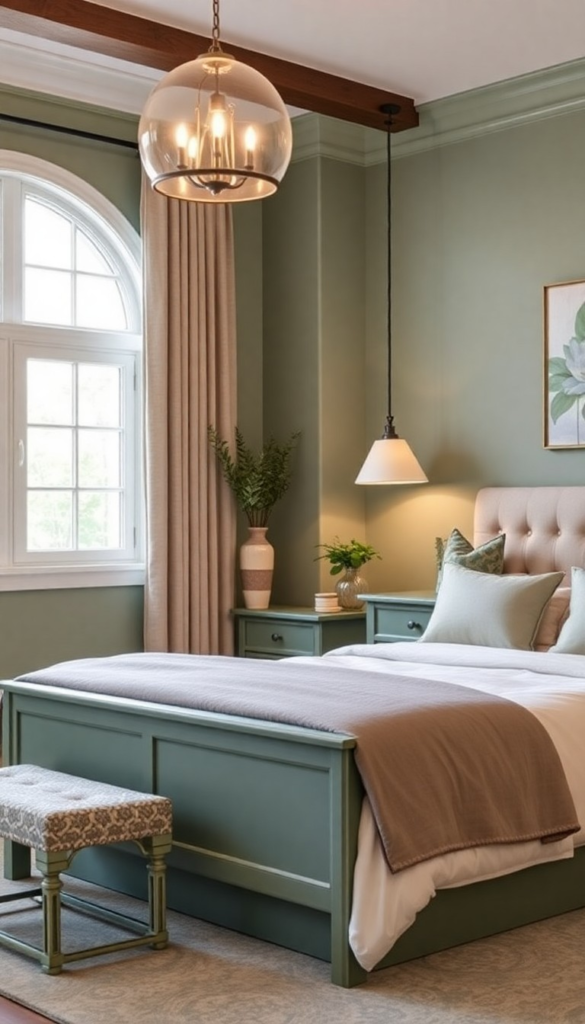
When it comes to furnishing a sage green bedroom, the devil is truly in the details.
Your furniture choices can either amplify the tranquil vibe of the room or clash awkwardly with the walls.
To ensure harmony, let’s explore three distinct styles—modern minimalist , rustic farmhouse , and bohemian chic —that not only complement sage green but also enhance its serene qualities.
Modern Minimalist: Sleek Simplicity
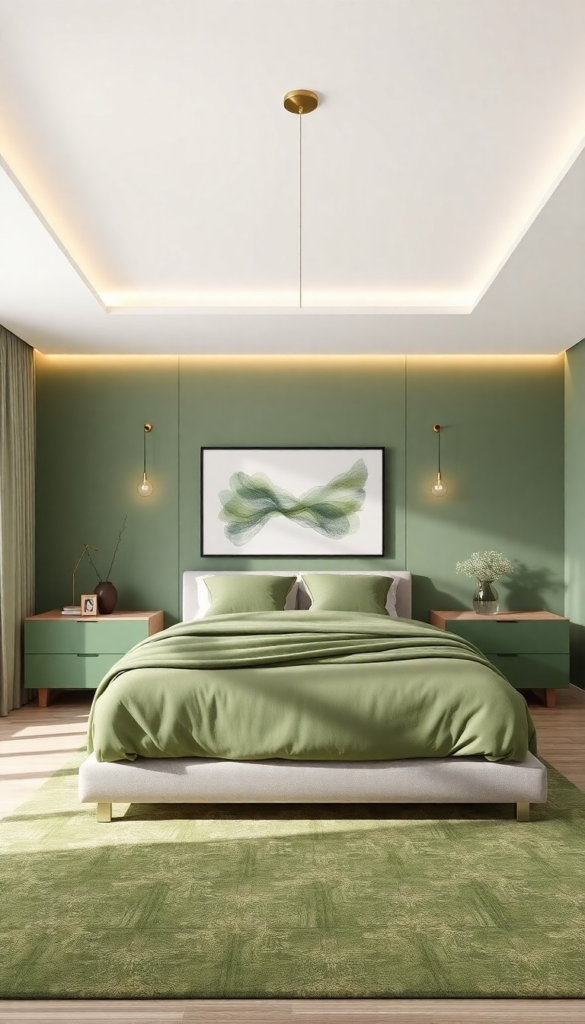
If you’re drawn to clean lines and uncluttered spaces, modern minimalist furniture is your go-to.
This style thrives on simplicity, allowing the sage green walls to breathe and shine.
Opt for pieces with slim profiles and neutral finishes like light oak , walnut , or white lacquer .
A platform bed with a low profile and built-in storage creates a streamlined look, while a sleek nightstand with hidden drawers adds functionality without visual bulk.
Accent pieces should follow suit—think geometric-shaped mirrors, transparent acrylic chairs, or a minimalist desk with metal legs.
Avoid ornate details; instead, focus on form and function.
One of my favorite tricks is to incorporate a statement chair in a complementary neutral tone, like a charcoal gray recliner or a cream-colored armchair.
It provides a cozy spot to read while maintaining the room’s airy feel.
Rustic Farmhouse: Cozy Charm
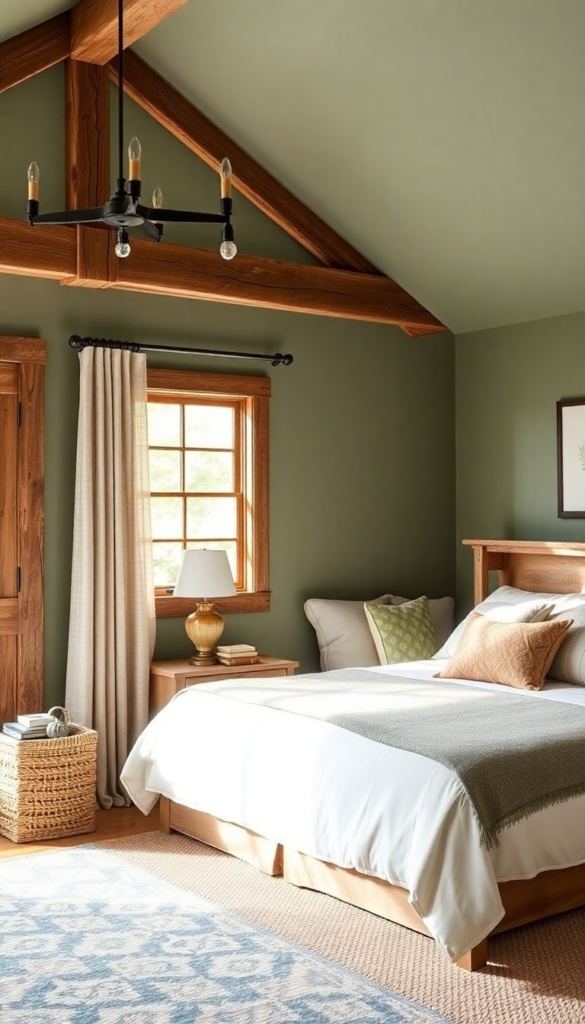
For those who crave warmth and texture, rustic farmhouse furniture pairs beautifully with sage green.
This style embraces imperfections, celebrating the beauty of natural materials like reclaimed wood , woven rattan , and distressed finishes .
Imagine a chunky wooden headboard with visible grain patterns or a vintage-inspired dresser with iron hardware.
These pieces add depth and character, making the room feel lived-in yet stylish.
Layering textures is key in a rustic farmhouse bedroom.
Start with a jute rug underfoot, then layer on plush wool throws and linen bedding.
Don’t forget to include decorative elements like mason jar vases, galvanized metal trays, or a reclaimed wood shelf displaying potted plants.
The combination of sage green walls and these tactile details creates a cozy retreat that feels like a warm embrace after a long day.
Bohemian Chic: Eclectic Energy

If your personality leans toward the free-spirited and unconventional, bohemian chic furniture is the perfect match for sage green.
This style thrives on eclecticism, blending patterns, textures, and colors in unexpected ways.
Start with a carved wooden bed frame featuring intricate designs or a wrought-iron canopy bed draped with flowing fabrics.
Mix and match chairs—perhaps a velvet armchair in mustard yellow alongside a rattan rocker—and don’t be afraid to experiment with mismatched side tables.
Textiles play a starring role in bohemian decor.
Layer rugs (yes, multiple!) in varying patterns and pile on cushions in bold prints like ikat, paisley, or tribal motifs.
Wall hangings, macramé art, and tasseled throw blankets add a playful touch.
The beauty of this style is its flexibility—you can swap out accessories seasonally or whenever inspiration strikes.
Sage green serves as the perfect backdrop, grounding the room while letting your creativity run wild.
No matter which style you choose, remember that scale matters.
Oversized furniture can overwhelm a smaller bedroom, while undersized pieces may get lost in a larger space.
Measure carefully and visualize how each piece will fit within the room’s layout.
And here’s a pro tip: invest in quality staples like a bed frame or dresser, but save room in your budget for fun, interchangeable accents that let you refresh the space easily.
Lighting Tips to Enhance Sage Green Walls
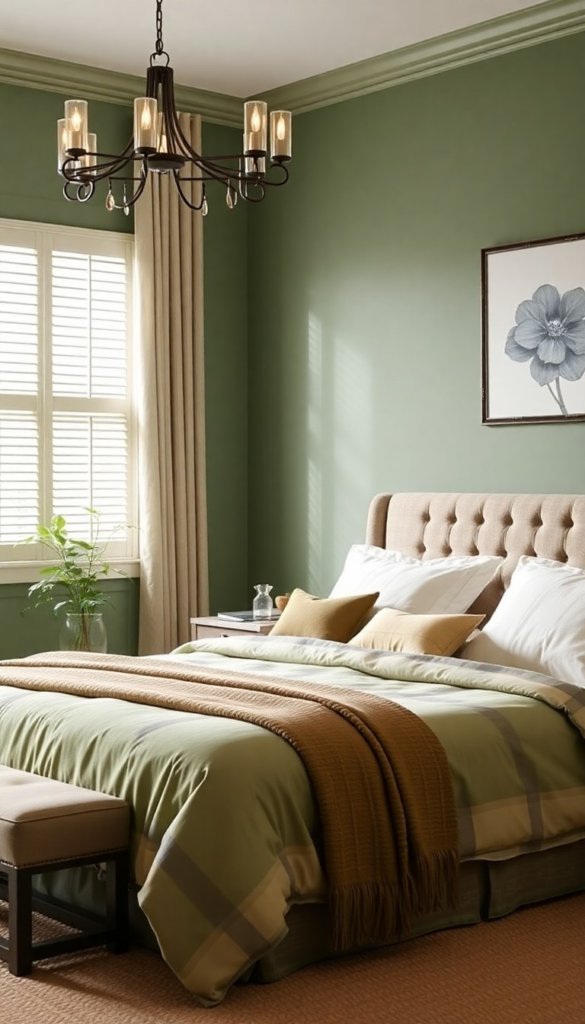
Lighting is the unsung hero of interior design, and when it comes to sage green walls, it’s the magic wand that can transform your bedroom from good to breathtaking.
Proper lighting doesn’t just illuminate a space—it shapes how colors appear, sets the mood, and creates layers of depth.
In a sage green bedroom, strategic lighting can amplify the calming qualities of the walls while adding warmth and dimension.
Let’s dive into how you can use lighting to make your sage green walls sing.
Layered Lighting: The Foundation of Ambiance
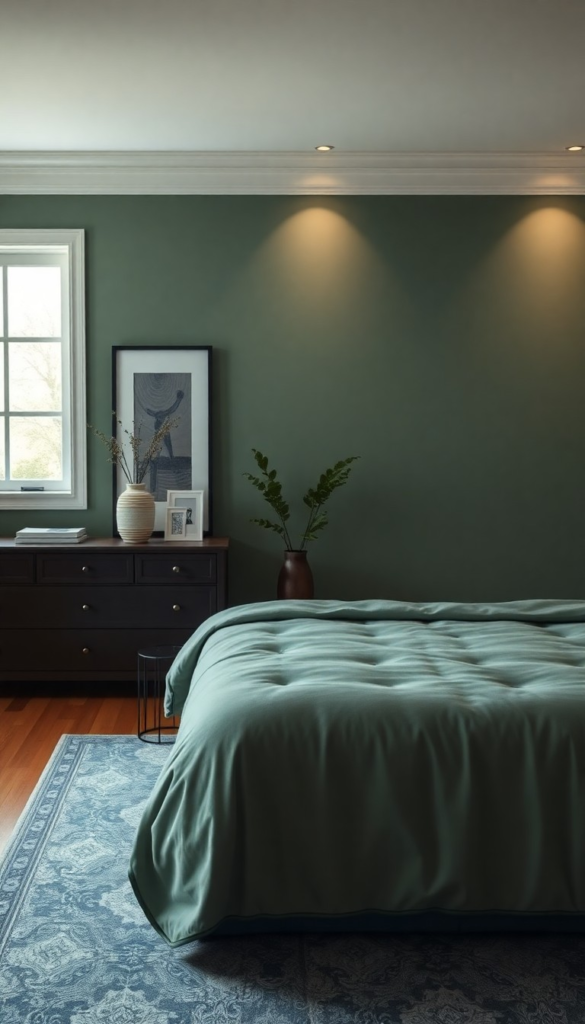
Think of lighting as a symphony, where each element plays a vital role.
Start with ambient lighting , the base layer that fills the room with a soft glow.
A ceiling-mounted fixture, like a chandelier or flush mount, works well here.
For a sage green bedroom, opt for fixtures with frosted glass or fabric shades to diffuse the light evenly.
Avoid harsh, uncovered bulbs that can wash out the wall color and create glare.
Next, introduce task lighting to address specific needs, such as reading or getting dressed.
Bedside lamps are essential in a bedroom, and for sage green walls, choose lamps with warm-toned bulbs (around 2700K-3000K on the Kelvin scale).
This range mimics the golden hour of natural sunlight, enhancing the earthy undertones of sage green.
Table lamps with ceramic or linen shades are particularly effective, casting a gentle light that feels cozy and inviting.
Finally, don’t forget accent lighting , which adds drama and highlights key features.
Picture a wall sconce flanking either side of your bed or a spotlight directed at a piece of art above your dresser.
LED strip lights tucked behind crown molding or under floating shelves create a subtle halo effect, making the sage green walls feel like they’re glowing from within.
Dimmer switches are a game-changer here—they allow you to adjust the intensity of each light source, giving you complete control over the room’s ambiance.
Natural Light: Maximizing What You Have
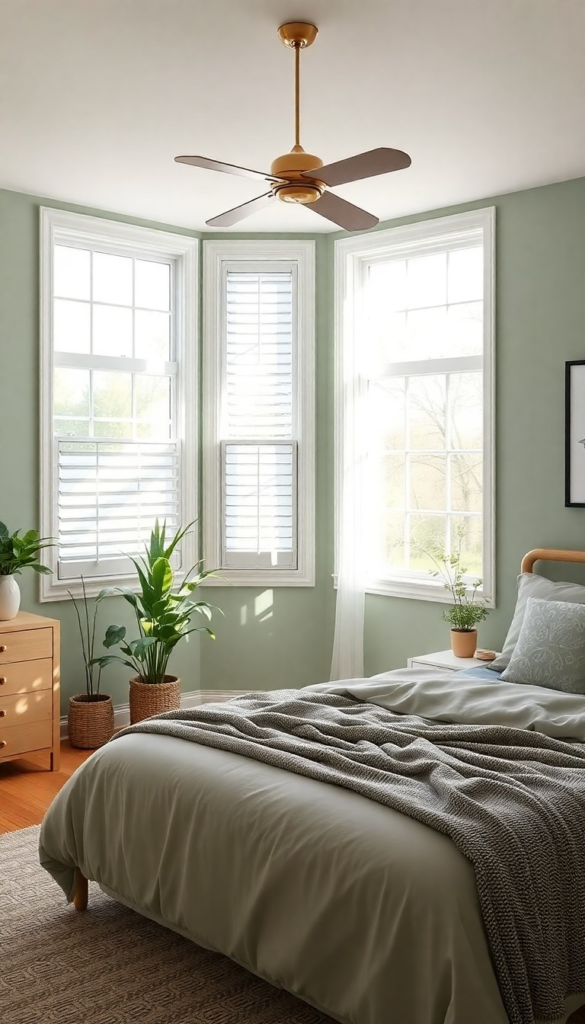
Natural light is the ultimate enhancer of sage green walls, so make the most of it.
If your bedroom gets plenty of sunlight, position your bed near the window to bask in the glow.
Sheer curtains or blinds let light filter through softly, preventing harsh shadows that can dull the color.
For rooms with limited natural light, mirrors are your best friend.
Place a large mirror opposite or adjacent to the window to reflect light back into the space, brightening the sage green walls and making the room feel more open.
Bulb Choices: The Devil’s in the Details
The type of bulb you choose can make or break the impact of your lighting.
Incandescent bulbs emit a warm, yellowish light that complements sage green beautifully, but they’re not the most energy-efficient option.
LED bulbs, on the other hand, come in a variety of color temperatures and are eco-friendly.
Stick to warm white LEDs (2700K-3000K) for a cozy feel, or experiment with smart bulbs that allow you to adjust the color temperature and brightness via an app.
Here’s a little secret: candlelight is the ultimate mood-setter.
Scatter a few pillar candles or tea lights around the room for a flickering glow that softens the edges of sage green walls.
It’s like turning your bedroom into a spa—without the hefty price tag.
By layering ambient, task, and accent lighting, maximizing natural light, and choosing the right bulbs, you can create a sage green bedroom that feels like a sanctuary.
Remember, lighting isn’t just functional—it’s transformative. Use it wisely, and watch your space come alive.
Textiles and Patterns That Bring Sage Green to Life
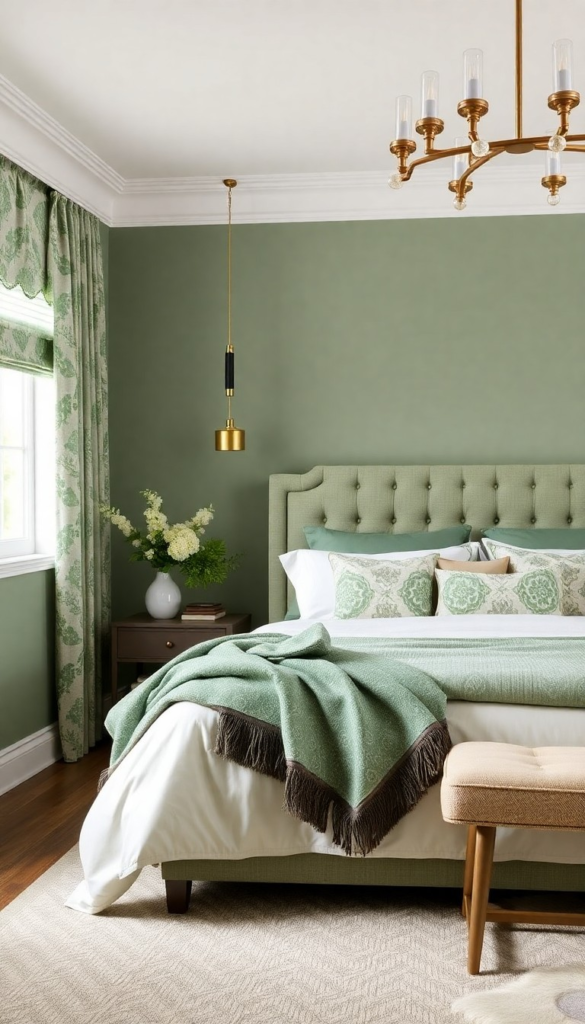
Textiles and patterns are the soul of any bedroom, and in a sage green space, they’re the tools you use to weave warmth, texture, and personality into the room.
Think of them as the spices in a recipe—they can elevate the dish (or in this case, the room) from bland to extraordinary.
The key is knowing how to mix and match these elements without overwhelming the serene foundation of sage green.
Let’s explore how to do it right.
Linen Bedding: Effortless Elegance
Linen is the MVP of bedding materials, especially in a sage green bedroom.
Its natural texture and breathable quality make it perfect for creating a relaxed yet refined look.
Opt for bedding in neutral shades like ivory , oatmeal , or soft gray to let the sage green walls take center stage.
If you want to add a touch of interest, choose a duvet cover or pillow sham with subtle embroidery or a delicate border in a complementary color like blush pink or mustard yellow.
Layering is crucial here. Start with a fitted sheet and flat sheet in solid colors, then add a quilt or coverlet for extra coziness.
Top it off with throw pillows in varying sizes and textures—think velvet, knit, or even faux fur.
A chunky knit throw folded at the foot of the bed adds a tactile element that invites you to snuggle up.
One of my favorite combinations? A sage green throw blanket paired with cream-colored pillows—it’s simple, timeless, and effortlessly chic.
Area Rugs: Grounding the Space
An area rug anchors the room and ties all the elements together.
In a sage green bedroom, choose a rug that complements the walls without competing with them.
Neutral rugs with subtle patterns—like a Moroccan-inspired design in ivory and charcoal or a sisal rug with a herringbone weave—are excellent choices.
They add visual interest without detracting from the calming vibe of the room.
If you’re feeling adventurous, go for a rug with a bolder pattern, like a floral motif or geometric print.
Just make sure the colors align with your overall palette.
For example, a rug with sage green accents and pops of terracotta or navy blue can tie the room together beautifully.
Pro tip: place the rug so that at least two-thirds of the bed sits on it. This creates a cohesive look and makes the space feel intentional.
Curtains: Framing the View
Curtains aren’t just functional—they’re an opportunity to enhance the room’s aesthetic.
For a sage green bedroom, lightweight fabrics like linen or cotton voile work wonders.
They let in natural light while maintaining privacy, creating a soft, ethereal effect.
Stick to neutral tones like beige or white for a clean, minimalist look, or opt for curtains in a deeper shade of green for a monochromatic scheme.
Patterns can also play a role here. If your bedding and rugs are relatively simple, consider curtains with a subtle stripe or floral print.
Just be mindful of scale—large patterns can overwhelm a small room, while smaller prints add charm without dominating the space.
I once used sage green curtains with a tiny leaf motif in my own bedroom, and it felt like bringing the outdoors inside.
It was a small change, but it made a big impact.
Mixing Textures and Patterns: The Art of Balance
The real magic happens when you mix textures and patterns thoughtfully.
Start with a neutral base—solid-colored bedding and rugs—and layer in patterns gradually.
For example, pair a striped throw pillow with a floral-patterned lumbar pillow, or combine a geometric rug with a paisley curtain.
The key is to vary the scale of the patterns; if one is large and bold, the others should be small and subdued.
Textures add another layer of interest. Combine smooth surfaces like silk or satin with rougher ones like wool or jute.
A velvet ottoman at the foot of the bed or a woven basket for storage introduces tactile variety that keeps the eye engaged.
Remember, the goal isn’t perfection—it’s creating a space that feels inviting and uniquely yours.
By carefully selecting textiles and patterns, you can transform your sage green bedroom into a haven of comfort and style.
Play around with combinations until you find what feels right.
After all, your bedroom should reflect your personality, not a Pinterest board.
Adding Decorative Elements for Depth and Interest
A sage green bedroom is like a blank canvas waiting for the artist’s final touches.
While the walls set the tone, it’s the decorative elements that truly bring the space to life.
These finishing touches—artwork, plants, mirrors, and accessories—are the brushstrokes that add depth, personality, and a sense of completion.
Let’s explore how to curate these details thoughtfully, ensuring they enhance rather than overwhelm your serene retreat.
Artwork: Telling Your Story
Artwork is more than decoration; it’s a reflection of who you are and what inspires you.
In a sage green bedroom, choose pieces that resonate with the room’s calming vibe.
Abstract paintings with soft, organic shapes in complementary colors like blush pink, mustard yellow, or deep teal can create a harmonious flow.
Alternatively, black-and-white photography or line drawings offer a minimalist contrast that keeps the focus on the walls.
Placement matters. Hang a large statement piece above the bed to anchor the space, or create a gallery wall with smaller framed prints for a curated look.
If you’re unsure about committing to permanent art, try leaning pieces against the wall on a dresser or shelf.
This casual approach feels modern and allows you to switch things up easily.
One of my favorite tricks? Using botanical prints or landscapes to reinforce the connection to nature that sage green inherently evokes.
Plants: Breathing Life into the Room
Plants are the ultimate decorators, bringing both beauty and vitality to a space.
In a sage green bedroom, they act as living accents that enhance the earthy undertones of the walls.
Low-maintenance options like snake plants , pothos , or ZZ plants thrive in indoor environments and require minimal care.
Place a tall fiddle-leaf fig in a corner to draw the eye upward, or cluster smaller plants like succulents on a windowsill or nightstand for a lush, layered effect.
For added flair, choose planters that complement your decor.
Terracotta pots lend a rustic charm, while ceramic vessels in matte white or soft gray keep things sleek and modern.
Hanging plants, like string of pearls or philodendrons, add vertical interest and soften hard edges.
Bonus: studies show that having plants in your bedroom can improve air quality and reduce stress. Talk about a win-win!
Mirrors: Expanding the Space
Mirrors are like magic wands for small bedrooms—they visually expand the space and amplify natural light.
In a sage green room, their reflective surfaces bounce light off the walls, making the color feel even more luminous.
Choose a mirror with a frame that matches your style: a round rattan mirror for a bohemian vibe, a gilded antique mirror for a touch of glamour, or a simple frameless design for a minimalist aesthetic.
Strategic placement is key.
Position a mirror opposite a window to maximize sunlight, or hang one above a dresser to create the illusion of height.
If floor space is limited, lean a large mirror against the wall—it’s a stylish alternative to traditional mounting.
I once placed a tall, arched mirror in my own bedroom, and it instantly transformed the room, making it feel airier and more open.
Accessories: The Final Flourishes
Accessories are the cherry on top, tying everything together with subtle yet impactful details.
Start with textiles—swap out throw pillows seasonally or drape a cozy blanket over a chair to keep the space feeling fresh.
Decorative objects like candles, books, and vases add personality without cluttering the room.
Stick to a cohesive color palette, incorporating shades that echo the sage green walls or introduce complementary hues.
Don’t forget about lighting accessories.
A sculptural table lamp or a pendant light with an interesting silhouette can double as both illumination and decor.
And for those who love a personal touch, display meaningful items like family photos, travel souvenirs, or handmade crafts.
These pieces tell your story and make the room uniquely yours.
By layering artwork, plants, mirrors, and accessories, you can infuse your sage green bedroom with depth and character.
The key is to edit thoughtfully—choose pieces that spark joy and align with your vision.
After all, the best spaces are those that feel authentic and lived-in.
Small Space Solutions for Sage Green Bedrooms
Designing a sage green bedroom in a small space can feel like trying to fit an elephant into a Mini Cooper—not impossible, but definitely tricky.
The good news? With clever strategies and thoughtful planning, you can create a serene retreat that maximizes every square inch without sacrificing style.
Here’s how to make the most of your compact sanctuary.
Vertical Storage: Reaching New Heights
When floor space is limited, think vertically.
Wall-mounted shelves are lifesavers in small bedrooms, offering storage without eating up precious real estate.
Install floating shelves above your bed or dresser to display books, plants, or decorative objects.
Not only do they free up surface space, but they also draw the eye upward, making the room feel taller and more open.
For clothing storage, consider a vertical wardrobe or tall bookcase.
Slim-profile wardrobes with sliding doors are ideal because they don’t require extra clearance to open.
If you’re handy, DIY shelving units can be customized to fit awkward corners or alcoves.
Pro tip: use matching baskets or bins to corral smaller items and maintain a tidy appearance.
I once turned a narrow closet into a vertical storage powerhouse with stackable bins and labeled boxes—it was a game-changer for keeping clutter at bay.
Multi-Functional Furniture: Double Duty Done Right
In a small bedroom, every piece of furniture should earn its keep.
Opt for multi-functional pieces that serve more than one purpose.
A bed with built-in drawers or a hydraulic lift for under-bed storage is a genius solution for stashing out-of-season clothes or extra linens.
Ottomans with hidden compartments or benches with lift-up seats provide additional storage while doubling as seating.
Consider a murphy bed if you need flexibility.
These beds fold up into the wall when not in use, freeing up floor space for other activities.
Pair it with a foldable desk or nesting tables that can be tucked away when not needed.
Another favorite of mine is the daybed with trundle —perfect for hosting guests without dedicating an entire room to a spare bed.
Mirrors and Light: Illusions of Grandeur
We’ve already touched on mirrors, but their importance in small spaces bears repeating.
A well-placed mirror can work wonders, reflecting light and creating the illusion of a larger room.
Lean a full-length mirror against a wall or hang one opposite a window to maximize natural light.
If you’re short on wall space, try a mirrored wardrobe or dresser—the reflective surface adds depth without taking up extra room.
Lighting also plays a critical role in making a small bedroom feel bigger.
Avoid heavy, bulky fixtures that can overwhelm the space.
Instead, opt for pendant lights , wall sconces , or track lighting that directs illumination where you need it most.
Dimmer switches are invaluable here, allowing you to adjust the brightness based on the time of day or activity.
Decluttering Secrets: Less Is More
The final piece of the puzzle is decluttering. In a small bedroom, even minor messes can make the space feel chaotic.
Adopt a “one in, one out” policy for belongings—if you bring something new into the room, remove something old.
Regularly reassess your possessions and donate or sell items you no longer use.
Vertical hooks on the back of doors or inside closets are great for organizing bags, scarves, or jewelry.
Remember, the goal isn’t to cram as much as possible into your sage green bedroom—it’s to create a functional, peaceful space that feels intentional.
By focusing on vertical storage, multi-functional furniture, strategic lighting, and smart decluttering, you can transform even the tiniest room into a serene oasis.
Seasonal Updates to Keep Your Sage Green Bedroom Fresh
Just like swapping out sweaters for sundresses, updating your sage green bedroom with the seasons keeps it feeling fresh and aligned with your mood.
The beauty of sage green is its versatility—it serves as a year-round foundation that adapts beautifully to seasonal shifts.
Here’s how to refresh your space without breaking the bank or starting from scratch.
Spring: Blooming with Renewal
Spring is all about renewal, so bring the outdoors in.
Swap out heavier textiles like wool throws and velvet pillows for lighter alternatives in linen or cotton.
Add pops of pastel colors—think blush pink, lavender, or baby blue—to mimic the soft hues of spring blooms.
Fresh flowers are a must; place a vase of tulips or daffodils on your nightstand or dresser to capture the season’s vibrancy.
If you have sheer curtains, now’s the time to let them shine, allowing more natural light to flood the room.
For a playful twist, incorporate botanical prints in your decor.
Swap out artwork or throw pillows for ones featuring floral motifs or leafy patterns.
Even something as simple as a new scented candle in a fresh citrus fragrance can signal the arrival of spring.
I once replaced my winter bedding with a crisp white duvet and sage green accent pillows, and it instantly made the room feel lighter and more inviting.
Summer: Embracing Warmth and Light
Summer calls for breezy, laid-back vibes.
Trade out dark wood furniture for lighter finishes like whitewashed oak or bamboo to keep the room feeling airy.
Layer in natural textures—rattan baskets, jute rugs, and woven wall hangings—that evoke a beachy, relaxed atmosphere.
Keep bedding minimal with lightweight fabrics like percale or chambray, and stick to a palette of whites, creams, and sandy neutrals to complement the sage green walls.
Don’t forget to update your lighting.
Opt for table lamps with linen shades or string lights draped casually around the room for a cozy, summery glow.
Incorporate nautical or tropical accents, like seashells or palm-print throw pillows, but use them sparingly to avoid kitsch.
One summer, I added a few driftwood pieces I’d collected from the beach to my nightstand—it was a small touch, but it brought the essence of summer indoors.
Fall: Cozying Up with Warmth
As the days grow shorter, it’s time to cozy up your sage green bedroom for fall.
Layer on the texture with chunky knit throws, faux fur pillows, and plush area rugs.
Rich, earthy tones like terracotta, mustard yellow, and deep burgundy pair beautifully with sage green, creating a warm and inviting atmosphere.
Consider swapping out lighter curtains for heavier drapes in a complementary color to block drafts and add insulation.
Decorative elements can also reflect the season.
Display pumpkins or gourds in varying sizes on your dresser or shelves, or hang a wreath made of dried leaves and twigs on the wall.
Candles in spiced scents like cinnamon or clove add a touch of autumnal charm.
Last fall, I switched out my bedside lampshade for one in a burnt orange hue—it was a subtle change, but it tied the whole room together.
Winter: Creating a Cozy Retreat
Winter is the season to embrace hygge, the Danish concept of coziness.
Drape your bed with a luxurious quilt or duvet in a deep jewel tone like emerald or navy to contrast with the sage green walls.
Add layers of warmth with velvet throw pillows and a sheepskin rug at the foot of the bed.
Metallic accents, like brass candlesticks or mercury glass vases, catch the light and add a festive sparkle.
Lighting becomes especially important during the darker winter months.
String fairy lights around your headboard or drape them along the walls for a magical glow.
Consider a Himalayan salt lamp for its soothing amber light and purported air-purifying benefits.
Finally, incorporate seasonal decor like evergreen branches or pinecone garlands to bring a touch of winter wonderland indoors.
One winter, I hung a small wreath above my bed and added a few sprigs of eucalyptus to my nightstand—it felt like a mini forest retreat.
By rotating textiles, decor, and lighting with the seasons, you can keep your sage green bedroom feeling dynamic and aligned with the rhythm of the year.
These updates don’t have to be drastic—even small changes can make a big impact.
Conclusion: Your Serene Sage Green Sanctuary Awaits
Transforming your bedroom into a serene sage green sanctuary isn’t just about aesthetics—it’s about creating a space that nurtures your well-being and reflects your personality.
From choosing the perfect shade to layering textures, lighting, and seasonal updates, every decision you make contributes to a room that feels uniquely yours.
Sage green is more than a color; it’s a mood, a vibe, a promise of calm amidst life’s chaos.
So, take the leap.
Whether you’re painting your walls, rearranging furniture, or simply swapping out throw pillows, remember that the smallest changes can yield the biggest rewards.
Trust your instincts, experiment fearlessly, and don’t be afraid to tweak until it feels just right.
After all, your bedroom is your personal haven—a place where you can recharge, dream, and simply be.
Now go ahead, roll up your sleeves, and start crafting the sage green sanctuary of your dreams.

